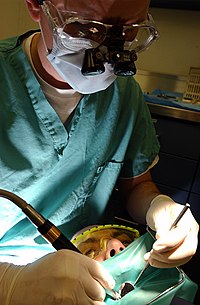
Photo from wikipedia
Introduction: Regeneration of the pulp‐dentin complex is the penultimate goal of regenerative endodontic procedures (REPs). Histological outcomes have demonstrated reparative tissue formation in human teeth extracted post‐REPs. However, lack of… Click to show full abstract
Introduction: Regeneration of the pulp‐dentin complex is the penultimate goal of regenerative endodontic procedures (REPs). Histological outcomes have demonstrated reparative tissue formation in human teeth extracted post‐REPs. However, lack of accurate characterization has precluded identification of the true nature of tissues formed post‐REP. Methods: Here, we present 2 case reports of tooth #29 and #9 treated with REPs and demonstrate their clinical, radiographic, and histological outcomes. Results: Clinical outcomes revealed healing of apical periodontitis in both teeth and re‐establishment of vitality responses in tooth #29. Moreover, radiographic assessments using 2D and 3D‐volumetric analyses demonstrate considerable increase in root development for both teeth. Further, histological outcomes evaluated using Hematoxylin and Eosin and immunohistochemical staining demonstrates presence of vascular and lymphatic structures as well as immune cell markers indicative of regeneration of an immunocompetent pulp. Lastly, examination of hard tissue deposition shows dentin‐like tissue in parts of tooth #29 demonstrating for the first time, regeneration of a pulp‐dentin complex post‐REP. Conclusions: Collectively, this is the first study demonstrating recapitulation of several tissues commonly found as part of a pulp‐dentin complex in teeth treated with REPs. HighlightsThis is the first case study showing characterization of tissue formed within regenerative endodontic procedure (REP)–treated teeth markers specific for various dentin‐pulp complex tissues.Tooth #29 and #9 demonstrate soft tissue as seen by the expression of vascular, neural, lymphatic, and immune cell markers.Tooth #29 demonstrates regeneration of dentinlike tissue as part of neotissues formed post‐REP.
Journal Title: Journal of Endodontics
Year Published: 2018
Link to full text (if available)
Share on Social Media: Sign Up to like & get
recommendations!